Table of Contents
Introduction
According to Functional Foods Statistics, Functional foods offer additional health benefits beyond basic nutrition and are essential in the health and nutrition sectors.
These include natural and modified foods enriched with fiber, vitamins, and probiotics to support health, such as boosting digestion and immunity and reducing disease risk.
With the functional foods market growing due to heightened health consciousness, an aging demographic, and healthcare costs, the sector faces challenges in proving health claims and ensuring taste.
However, the evolving food science field and increased health interest present promising expansion prospects, highlighting its crucial impact on improving global health.
Editor’s Choice
- The global functional foods market revenue is projected to reach USD 678.3 billion by 2032.
- Among the product categories, dairy products have consistently led the market, with revenues growing from USD 91.9 billion in 2022 to USD 203.5 billion in 2032.
- In the composition of the functional foods market, vitamins lead with a market share of 30%, underscoring their pivotal role in enhancing health beyond basic nutrition.
- Fortified cereals may contain approximately 25-100% of the recommended daily intake (RDI) for various vitamins and minerals per serving.
- North America led the surge in the sale of functional food ingredients, escalating from USD 20,930 million in 2016 to USD 32,015 million by 2023.
- According to the survey data, a majority of respondents, constituting 55%, expressed a preference for incorporating functional ingredients into their diet through supplements, such as tablets, capsules, gummies/chewables, or tinctures.
- In 2021, 7% of consumers in the United States acknowledged that FFAB could be beneficial to the body, recognizing their potential health advantages.
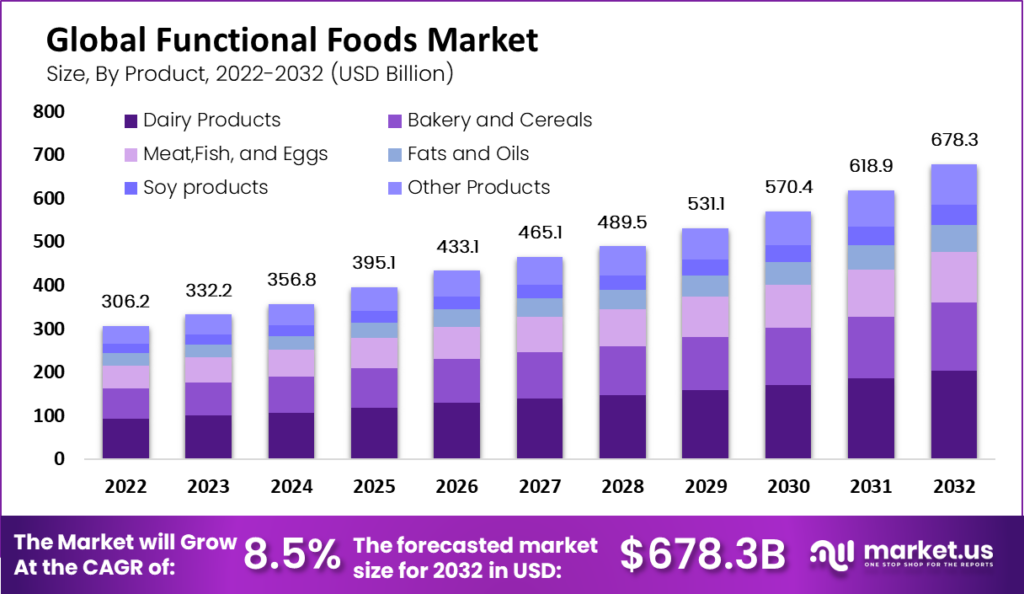
Global Functional Foods Market Overview
Global Functional Foods Market Size
- The global functional foods market has shown a significant upward trend in revenue from 2022 to 2032 at a CAGR of 8.5%.
- Starting at USD 306.2 billion in 2022, the market experienced steady growth, reaching USD 332.2 billion in 2023, and is projected to continue growing to USD 356.8 billion in 2024.
- The upward trajectory is expected to persist, with market revenues forecasted to climb to USD 395.1 billion in 2025, USD 433.1 billion in 2026, and further to USD 465.1 billion by 2027.
- The market is projected to reach new heights with revenues of USD 618.9 billion in 2031, culminating in an impressive USD 678.3 billion by 2032.
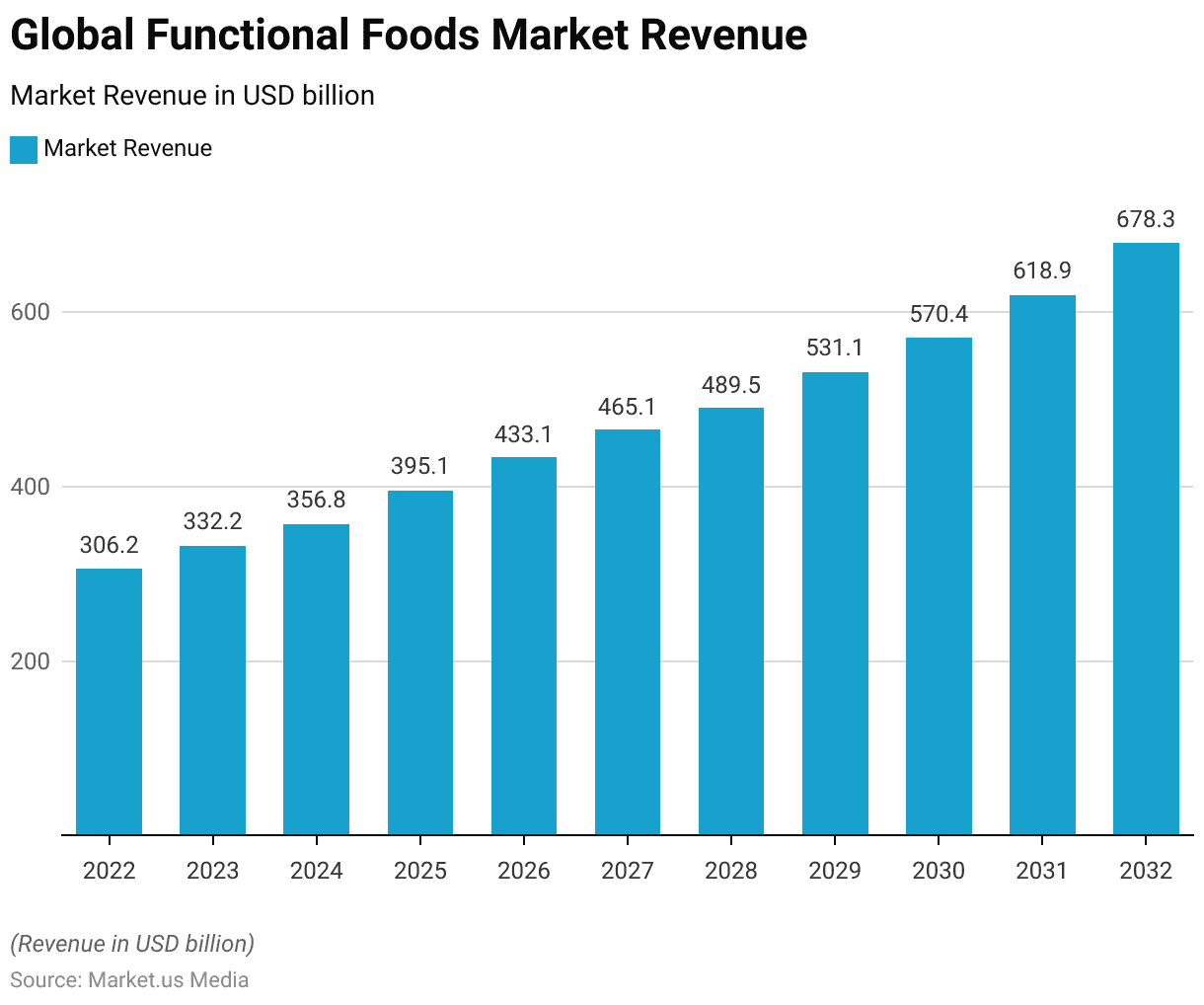
Functional Foods Market Size- By Product
- The global functional foods market has exhibited robust growth from 2022 to 2032 among different product types.
- Among the product categories, dairy products have consistently led the market, with revenues growing from USD 91.9 billion in 2022 to USD 203.5 billion in 2032.
- Bakery and cereals followed, with their revenue rising from USD 70.4 billion to USD 156.0 billion over the same period.
- The meat, fish, and eggs category also showed significant growth, from USD 53.3 billion to USD 118.0 billion.
- Fats and oils, as well as soy products, have seen substantial increases in their market shares, with revenues moving from USD 27.6 billion and USD 21.4 billion in 2022 to USD 61.0 billion and USD 47.5 billion in 2032, respectively.
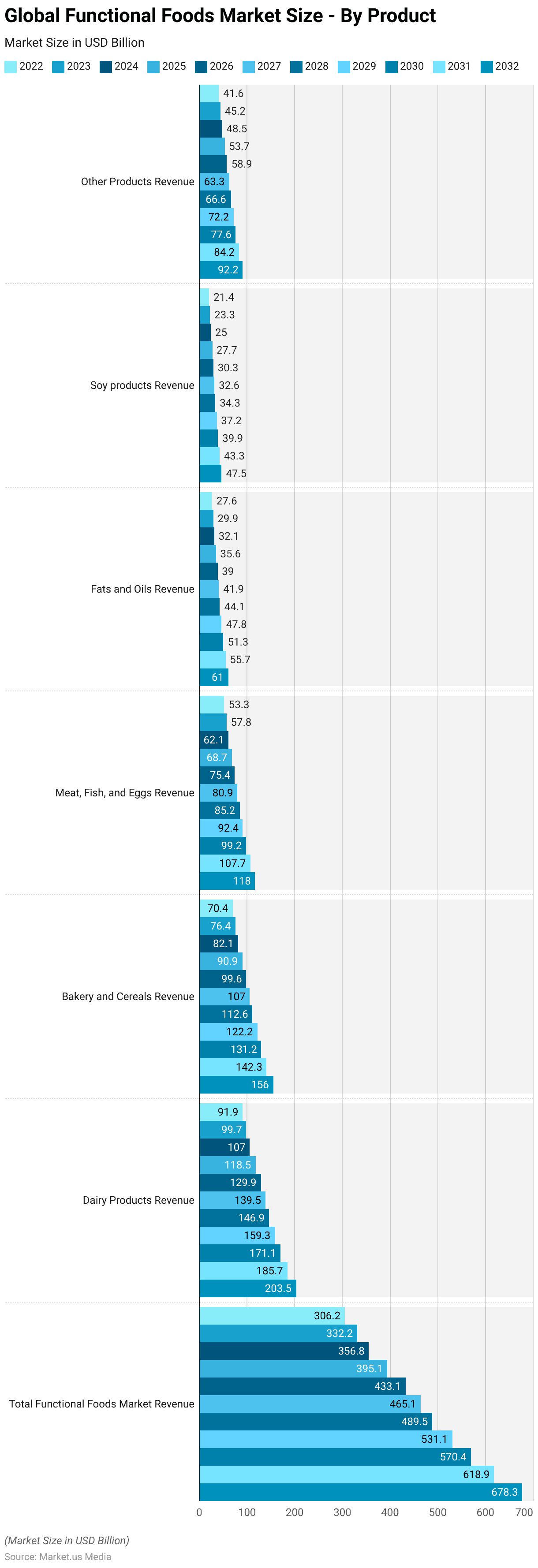
Functional Foods Market Share- By Ingredient
- In the composition of the functional foods market, vitamins lead with a market share of 30%, underscoring their pivotal role in enhancing health beyond basic nutrition.
- Carotenoids follow closely, contributing to 24% of the market, and are recognized for their antioxidant properties and health benefits.
- Dietary fibers hold a 14% share, highlighting their importance in digestive health and disease prevention.
- Minerals, essential for various bodily functions, account for 13% of the market. Probiotics and prebiotics, known for their beneficial effects on gut health, comprise 5% of the market.
- The remaining 14% is attributed to other ingredients, showcasing the diversity and innovation within the functional foods sector.
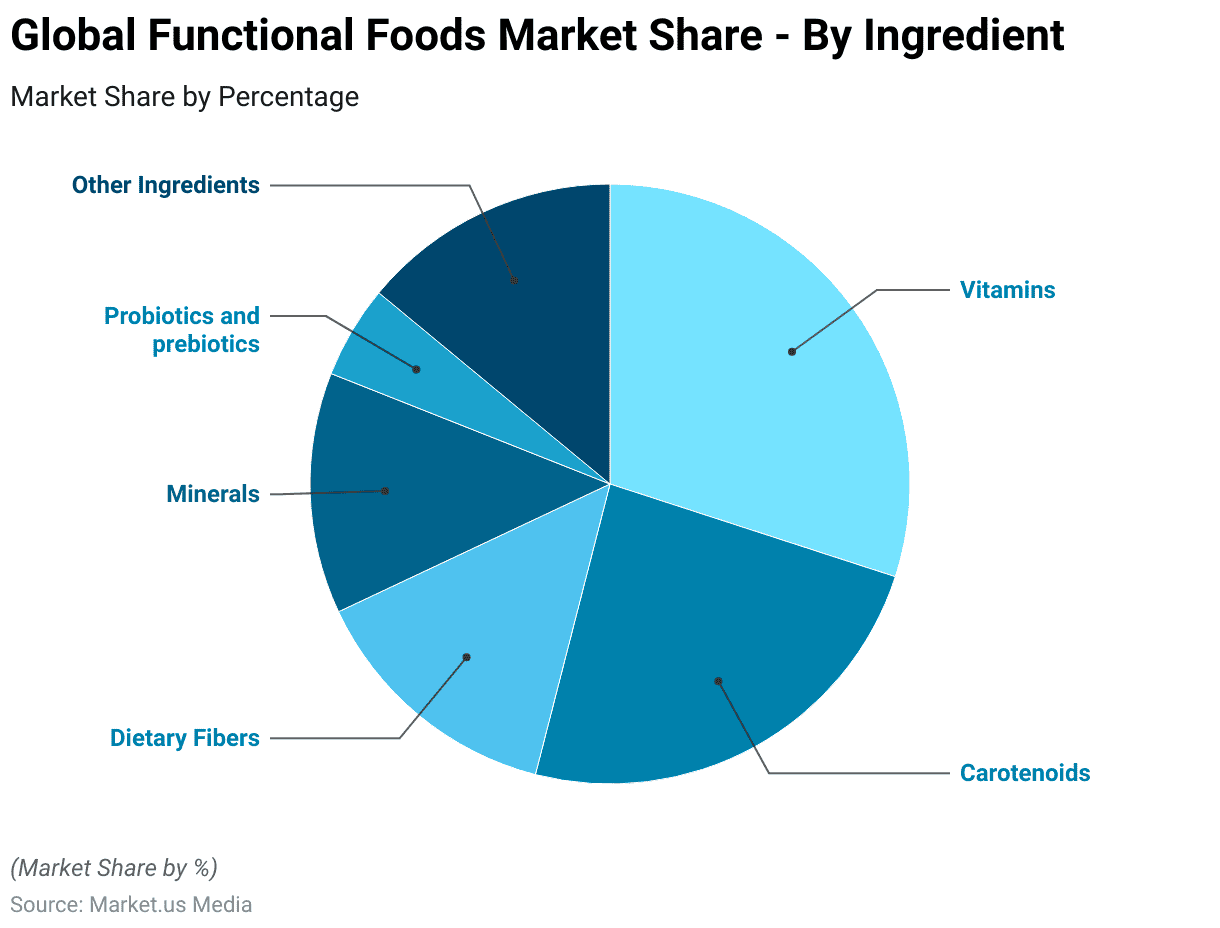
Nutritional Content of Functional Food
Vitamins and Minerals
- Fortified cereals may contain approximately 25-100% of the recommended daily intake (RDI) for various vitamins and minerals per serving.
- Fortified milk may provide around 30-50% of the RDI for calcium and vitamin D per cup.
- Vegetables like spinach and kale are rich sources of vitamins A, C, and K, providing well over 100% of the RDI per serving.
Antioxidants
- Blueberries typically contain around 5-9 millimoles of antioxidants per 100 grams.
- Dark chocolate with a high cocoa content (70-85%) may provide approximately 15-20 millimoles of antioxidants per 100 grams.
Omega-3 Fatty Acids
- Fatty fish like salmon typically contain around 1-2 grams of omega-3 fatty acids per 100 grams.
- Flaxseeds and chia seeds provide approximately 18-25 grams of alpha-linolenic acid (ALA), a type of omega-3 fatty acid, per ounce (28 grams).
Probiotics and Prebiotics
- A serving of yogurt with live cultures may contain around 1-10 billion CFUs of probiotics.
- Prebiotic-rich foods like chicory root may provide 2-5 grams of inulin fiber per tablespoon.
Fiber
- Fiber content varies widely among foods, with whole grains, legumes, fruits, and vegetables typically providing several grams of fiber per serving.
- One cup of cooked lentils contains approximately 15-16 grams of dietary fiber.
- An apple with the skin intact provides about 4-5 grams of fiber.
Sales of Functional Food Ingredients – By Region
- From 2016 to 2023, the global market for functional food ingredients witnessed significant growth across various regions.
- North America led the surge, with sales escalating from USD 20,930 million in 2016 to USD 32,015 million by 2023, indicating a robust demand for health-enhancing food components.
- Europe followed closely, with its sales increasing from USD 19,555 million in 2016 to USD 28,798 million in 2023, reflecting a steady appetite for functional foods.
- The Asia Pacific region also showed remarkable growth, starting from USD 13,139 million in 2016 and reaching USD 21,445 million in 2023, as awareness and consumption of functional ingredients expanded.
- South America, while smaller in market size compared to the other regions, experienced consistent growth from USD 7,639 million in 2016 to USD 11,948 million in 2023, underscoring the increasing recognition of the health benefits associated with functional food ingredients.
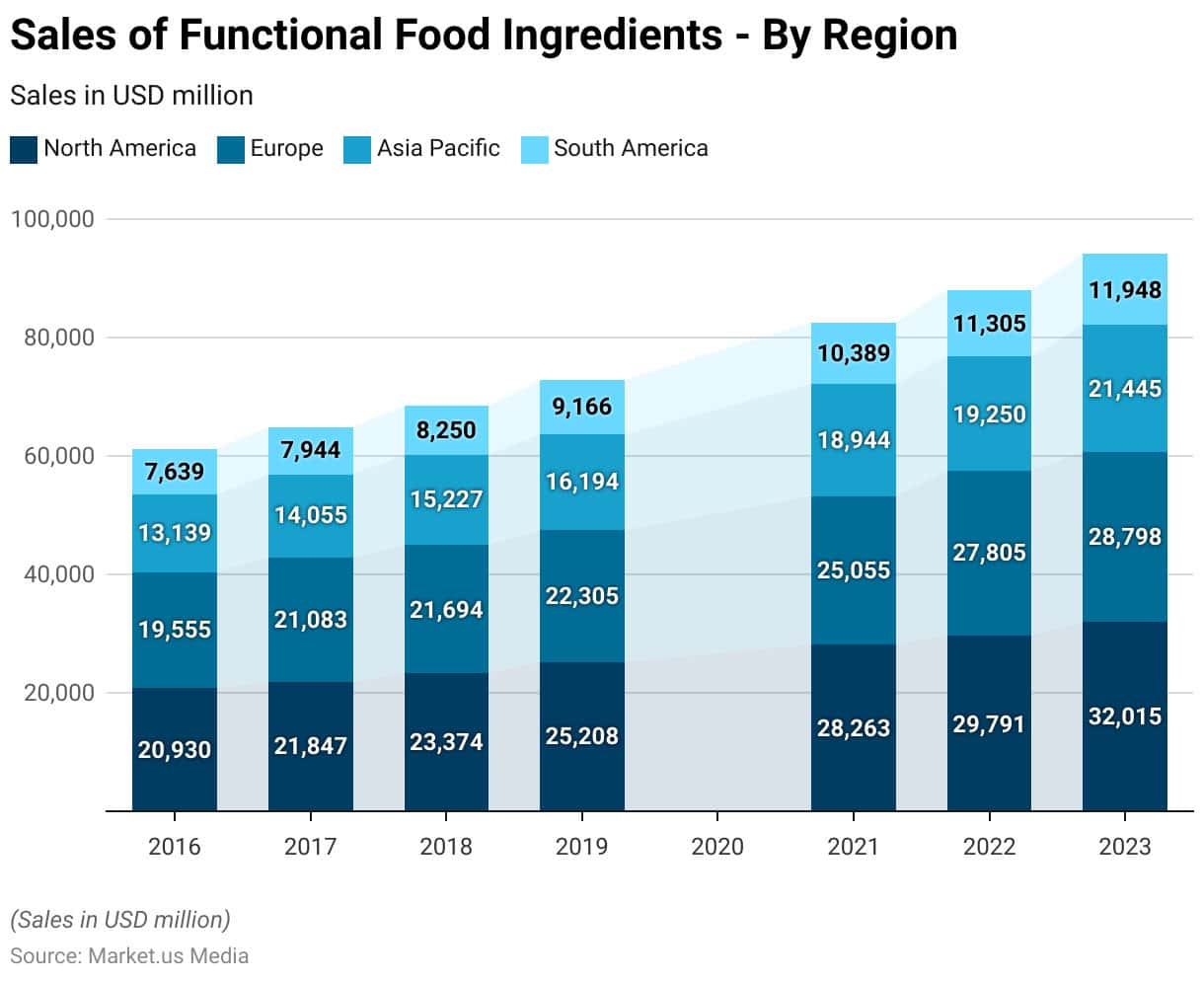
Addition of Functional Food Ingredients to the Diet
- According to the survey data, a majority of respondents, constituting 55%, expressed a preference for incorporating functional ingredients into their diet through supplements, such as tablets, capsules, gummies/chewables, or tinctures.
- Close behind, 45% favored inherently nutritious and naturally functional foods without requiring fortification, such as whole grains and fresh produce.
- In terms of beverages, 35% leaned towards inherently functional options like bottled water or fruit/vegetable juice.
- However, a notable portion, 25%, showed a preference for functional foods with added fortification, while 21% favored fortified beverages.
- Interestingly, 15% indicated no specific preference and were open to using any of the methods above to incorporate functional ingredients into their diet.
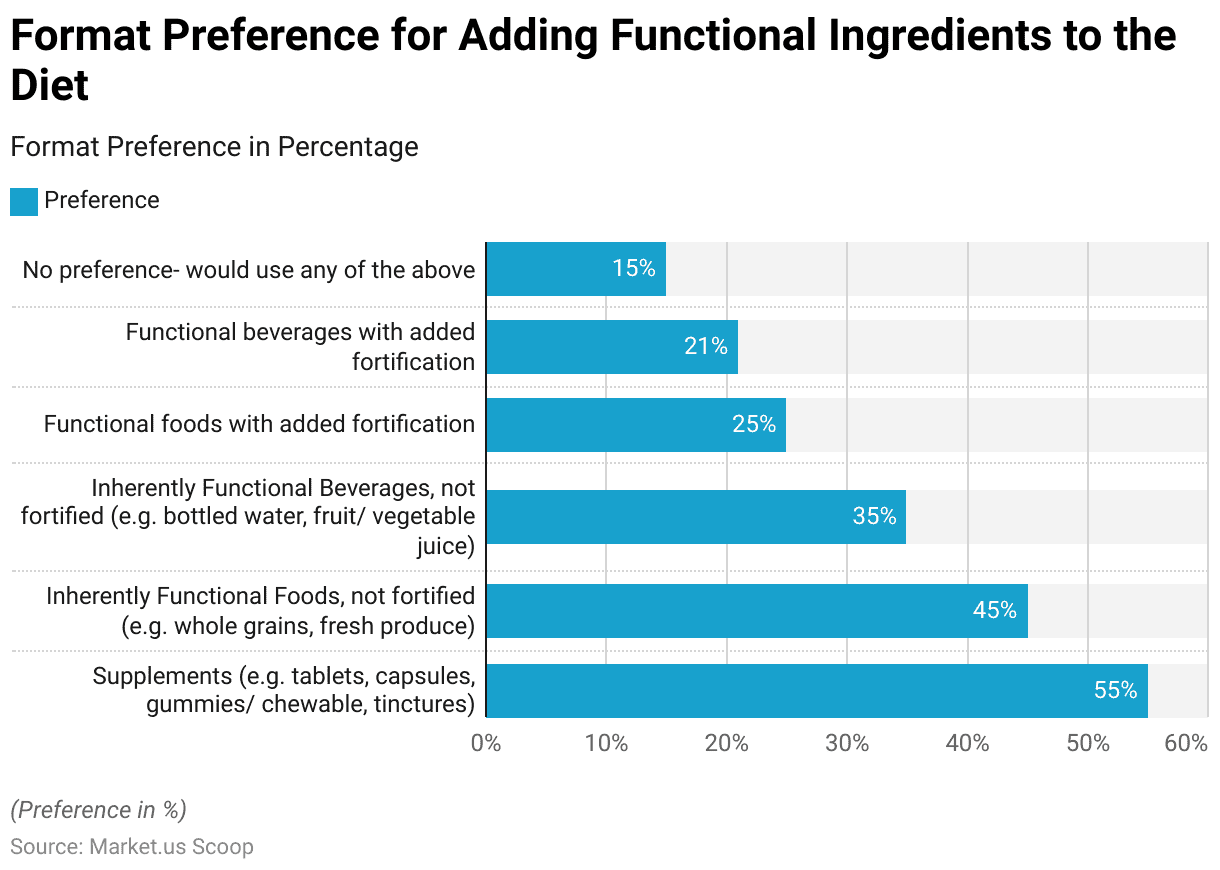
Consumer Preferences
Incorporation of Various Functional Food Ingredients into the Diet
- Recent data reveals the top functional foods and ingredients that Americans are actively seeking to include in their diets.
- Topping the list is fiber, with 63% of consumers striving to incorporate it, followed closely by protein at 60% and vitamin D at 59%.
- Whole grains, nuts, and seeds are also highly sought after, with 58% and 57% respectively.
- Additionally, essential nutrients like calcium and healthy fats are being actively pursued by 54% and 39% of consumers, respectively.
- Notably, olive oil, antioxidants, and green tea are also popular choices, with 51%, 43%, and 42% of consumers aiming to add them to their diets, respectively.
- Meanwhile, omega-3 fatty acids and fish oil are sought after by 42% and 40% of consumers, highlighting a growing interest in heart-healthy fats.
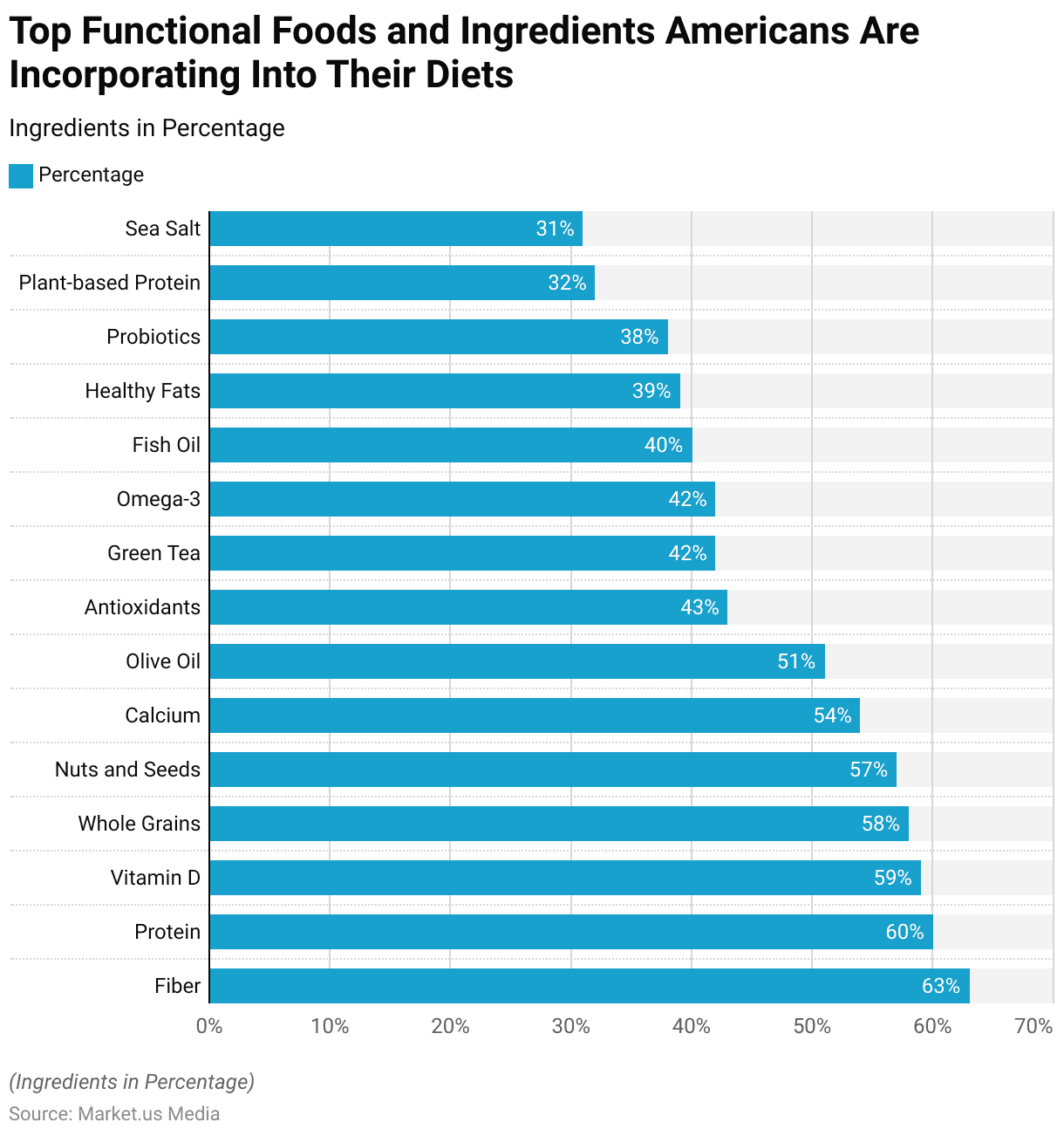
Consumers Perspective on Fortified Food and Beverages (FFAB)
- In 2021, consumers in the United States expressed various perspectives on fortified food and beverages (FFAB) through percentages.
- A notable portion, comprising 27%, acknowledged that FFAB could be beneficial to the body, recognizing their potential health advantages.
- Additionally, 24% recognized the widespread availability of FFAB in the food supply, indicating their prevalence in the market.
- A significant number, totaling 23%, believed that fortification played a crucial role in improving overall nutrition, highlighting its importance in enhancing dietary quality.
- Moreover, 23% viewed FFAB as a convenient means to increase vitamin intake, while 21% recognized their ability to boost nutrient density.
- A similar percentage, also at 21%, considered fortification the safest method for adding essential vitamins to the diet, emphasizing safety concerns.
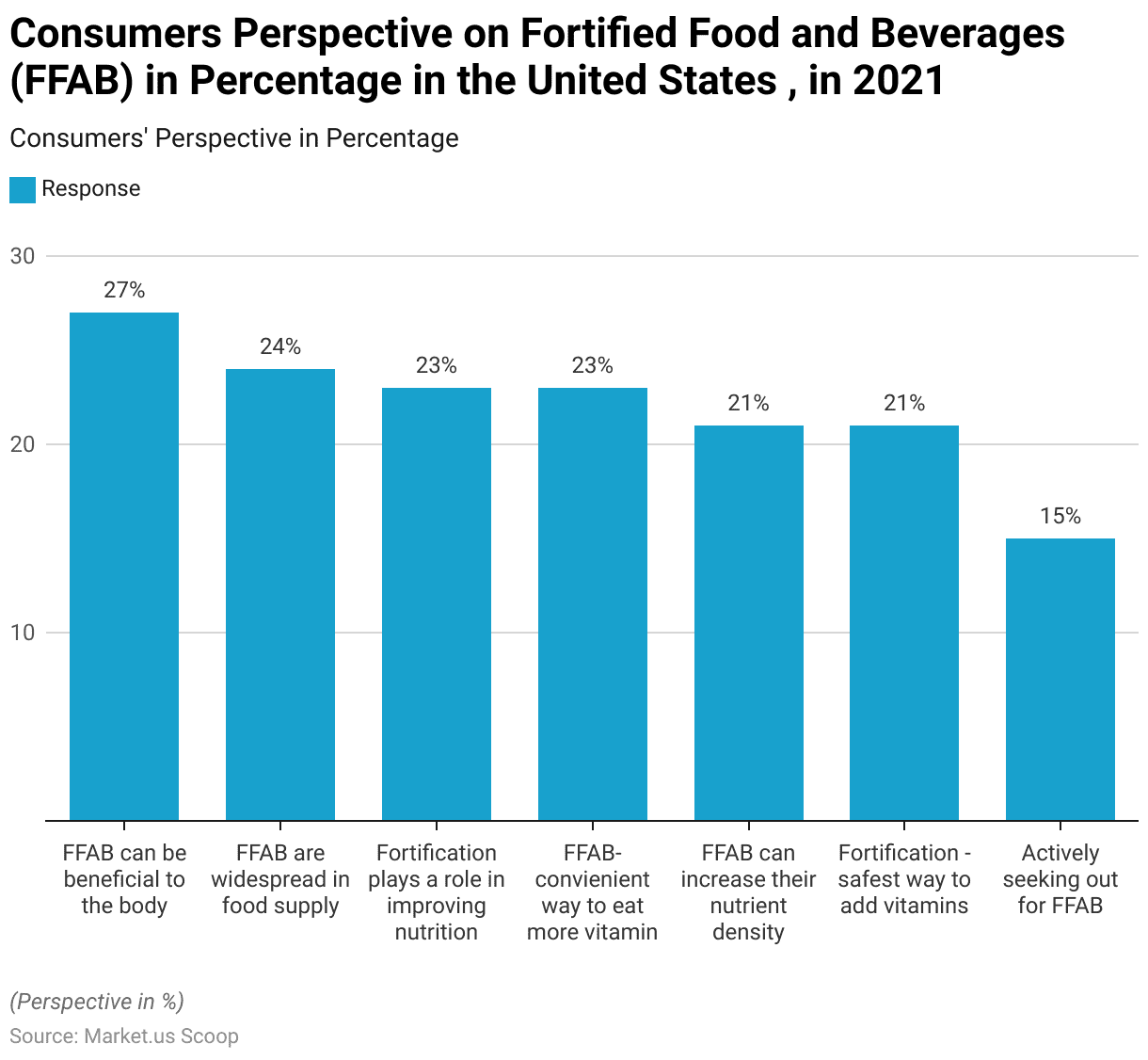
Regulations for Functional Foods in Various Nations
United States (U.S.)
- In the U.S., functional foods are regulated by the Food and Drug Administration (FDA) under the category of “dietary supplements” or “conventional foods.”
- The Dietary Supplement Health and Education Act (DSHEA) of 1994 governs dietary supplements, while the Federal Food, Drug, and Cosmetic Act (FD&C Act) regulates conventional foods, including functional foods.
- The FDA requires that functional foods and dietary supplements be safe for consumption and have accurate labeling, including claims about health benefits.
European Union (EU)
- In the EU, functional foods fall under the category of “novel foods” or “dietary supplements.”
- The European Food Safety Authority (EFSA) evaluates novel foods to ensure they are safe for consumption before they can be placed on the market.
- Regulation (EU) 2015/2283 on novel foods governs the authorization and marketing of novel foods in the EU.
- Health claims on functional foods are regulated under Regulation (EC) No 1924/2006, which requires scientific substantiation for any claims made.
Japan
- In Japan, functional foods are known as “Foods for Specified Health Uses” (FOSHU) and are regulated by the Ministry of Health, Labour and Welfare (MHLW).
- FOSHU must undergo rigorous testing to demonstrate their safety and efficacy before they can be marketed with specific health claims.
- The Japanese government also regulates functional foods through the Food Sanitation Act and other relevant legislation to ensure consumer safety and proper labeling.
Discuss your needs with our analyst
Please share your requirements with more details so our analyst can check if they can solve your problem(s)



